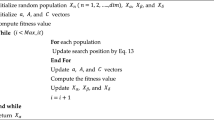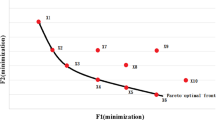Abstract
Grey wolf optimizer (GWO) is an efficient meta-heuristic algorithm that is inspired by the particular hunting behavior and leadership hierarchy of grey wolves in nature. In this paper, an efficient opposition-based grey wolf optimizer algorithm is proposed for solving the fuzzy clustering problem over artificial and real-life data. This work also tries to use the benefit of fuzzy properties which presents capability to handle overlapping clusters. However, centroid information and geometric structure information of clusters are the two important issues in fuzzy data clustering to improve the clustering performance. According to, in this paper, we derive two-objective functions, such as compactness and overlap–partition (OP) measures to handle above drawbacks. The centroid information issue is solved by compactness measure, and the OP measure is used to handle the geometric structure of clustering problem. Additionally, in the proposed clustering approach, the concept of opposition-based generation jumping and opposition-based population initialization is used with the standard GWO to enhance its computational speed and convergence profile. The efficiency of the proposed algorithm is shown for five artificial datasets and five real-life datasets of varying complexities. Experimental results show that the proposed method outperforms some existing methods with good clustering qualities.


















Similar content being viewed by others
References
Amiri E, Mahmoudi S (2016) Efficient protocol for data clustering by fuzzy Cuckoo Optimization Algorithm. Appl Soft Comput 41:15–21
Armano G, Mohammad Reza F (2016) Multi-objective clustering analysis using particle swarm optimization. Expert Syst Appl 55:184–193
Bandyopadhyay S, Saha S (2008) A point symmetry based clustering technique for automatic evolution of clusters. IEEE Trans Knowl Data Eng 20:1–17
Bezdek JC (1973) Fuzzy mathematics in pattern classification, Ph.D. Thesis, Cornell University, Ithaca, NY
Bezdek JC, Ehrlich R, Full W (1984) FCM: the fuzzy c-means clustering algorithm. Comput Geosci 10:191–203
Bharti KK, Singh PK (2016) Opposition chaotic fitness mutation based adaptive inertia weight BPSO for feature selection in text clustering. Appl Soft Comput 43:20–34
Cai L, Yao X, He Z, Liang X (2010) K-means clustering analysis based on immune genetic algorithm. In: World automation congress (WAC), IEEE, pp 413–418
Capitaine HL, Frélicot C (2008) A family of cluster validity indexes based on a \(l\)-order fuzzy or operator. Lect Notes Comput Sci 5342:622–631
Capitaine HL, Frélicot C (2011) A cluster-validity index combining an overlap measure and a separation measure based on fuzzy-aggregation operators. IEEE Trans Fuzzy Syst 19:580–588
Chang DX, Zhang XD, Zheng CW (2009) A genetic algorithm with gene rearrangement for k-means clustering. Pattern Recognit 42:1210–1222
Gan G, Ma C, Wu J (2007) Data clustering: theory, algorithms, and applications. Society for Industrial and Applied Mathematics, Philadelphia
Gowthul Alam MM, Baulkani S (2016) A hybrid approach for web document clustering using K-means and artificial bee colony algorithm. Int J Intell Eng Syst 9(4):11–20
Handl J, Knowles J (2004) Evolutionary multi-objective clustering. In: Proceedings of the eighth international conference on parallel problem solving from nature, Springer, pp 1081–1091
Hruschka ER, Campello RJ, Freitas AA (2009) A survey of evolutionary algorithms for clustering. IEEE Trans Syst Man Cybern Part C Appl Rev 39(2):133–155
Izakian H, Abraham A (2011) Fuzzy c-means and fuzzy swarm for fuzzy clustering problem. Expert Syst Appl 38:1835–1838
Jensi R, Jiji GW (2016) An improved krill herd algorithm with global exploration capability for solving numerical function optimization problems and its application to data clustering. Appl Soft Comput 46:230–245
Jiao LC, Shang F, Wang F, Liu Y (2012) Fast semi-supervised clustering with enhanced spectral embedding. Pattern Recognit 45(12):4358–4369
Karaboga D, Ozturk C (2011) A novel clustering approach: Artificial Bee Colony (ABC) algorithm. Appl Soft Comput 11:652–657
Kim D-W, Lee KH, Lee D (2004) On cluster validity index for estimation of the optimal number of fuzzy clusters. Pattern Recognit 37:2009–2025
Li C, Zhou J, Kou P, Xiao J (2012) A novel chaotic particle swarm optimization based fuzzy clustering algorithm. Neuro Comput 83:98–109
Li L, Jiao L, Zhao J, Shang R, Gong M (2017) Quantum-behaved discrete multi-objective particle swarm optimization for complex network clustering. Pattern Recognit 63:1–14
Luo J, Jiao L, Lozano JA (2016) A sparse spectral clustering framework via multi-objective evolutionary algorithm. IEEE Trans Evol Comput 20(3):418–433
Ma Y, Niu P, Zhao Y, Ma X (2011) Adaptive particle swarm-based fuzzy clustering algorithm in the application of steam drum pulverized coal fired boiler. Int J Adv Comput Technol 3(11):444–452
MacQueen J (1967) Some methods for classification and analysis of multivariate observations. In: Proceedings of the fifth Berkeley symposium on mathematical statistics and probability, vol 1, No 14
Mascarilla L, Berthier M, Frélicot C (2008) A k-order fuzzy or operator for pattern classification with k-order ambiguity rejection. Fuzzy Sets Syst 159:2011–2029
Maulik U, Bandyopadhyay SBS (2000) Genetic algorithm-based clustering technique. Pattern Recognit 33:1455–1465
Min W, Siqing Y (2010) Improved k-means clustering based on genetic algorithm. In: 2010 international conference on computer application and system modeling (ICCASM), vol 6, IEEE
Mukhopadhyay A (2014) A survey of multi-objective evolutionary algorithms for data mining: part ii. IEEE Trans Evol Comput 18(1):20–35
Niu Q, Huang X (2011) An improved fuzzy C-means clustering algorithm based on PSO. JSW 6(5):873–879
Pimentel BA, De Souza RM (2013) A multivariate fuzzy c-means method. Appl Soft Comput 13(4):1592–1607
Pimentel BA, Souza RM (2014) A weighted multivariate fuzzy c-means method in interval-valued scientific production data. Expert Syst Appl 41(7):3223–3236
Ripon KSN, Tsang C-H, Kwong S (2006) Multi-objective data clustering using variable-length real jumping genes genetic algorithm and local search method. In: International joint conference on neural networks, IEEE, pp 3609–3616
Rui X, Wunsch D (2005) Survey of clustering algorithms. IEEE Trans Neural Netw 16(3):645–678
Saha S, Bandyopadhyay S (2010) A symmetry based multi-objective clustering technique for automatic evolution of clusters. Pattern Recognit 43(3):738–751
Seyedali M, Mohammad MS, Andrew L (2014) Grey wolf optimizer. Adv Eng Softw 69:46–61
Shang R, Zhang Z, Jiao L, Liu C, Li Y (2016a) Self-representation based dual-graph regularized feature selection clustering. Neurocomputing 171:1242–1253
Shang R, Zhang Z, Jiao L, Wang W, Yang S (2016b) Global discriminative-based nonnegative spectral clustering. Pattern Recognit 55:172–182
Shouwen C, Xu Z, Tang Y (2014) A hybrid clustering algorithm based on fuzzy c-means and improved particle swarm optimization. Arabian J Sci Eng 39(12):8875–8887
Szabo A, de Castro LN, Delgado MR (2011) The proposal of a fuzzy clustering algorithm based on particle swarm. In: IEEE third world congress on nature and biologically inspired computing (NaBIC)
Tizhoosh HR (2005) Opposition-based learning: a new scheme for machine intelligence. In: Proceedings of the international conference on computation intelligence on modelling control automation and international conference on intelligent agents, Web Tech Internet Commerce, pp 695–701
Tizhoosh HR (2006) Opposition-based reinforcement learning. J Adv Comput Intell Intell Inform 10(3):578–585
Vinu Sundararaj (2016) An efficient threshold prediction scheme for wavelet based ECG signal noise reduction using variable step size firefly algorithm. Int J Intell Eng Syst 9(3):117–126
Wikaisuksakul S (2014) A multi-objective genetic algorithm with fuzzy c-means for automatic data clustering. Appl Soft Comput 24:679–691
Zhang YC, Xiong X, Zhang QD (2013) An improved self-adaptive PSO algorithm with detection function for multimodal function optimization problems. Math Probl Eng 2013:8. https://doi.org/10.1155/2013/716952
Zhang M, Jiao L, Ma W, Ma J, Gong M (2016) Multi-objective evolutionary fuzzy clustering for image segmentation with MOEA/D. Appl Soft Comput 48:621–637
Author information
Authors and Affiliations
Corresponding author
Ethics declarations
Conflict of interest
The authors declare that they have no conflict of interest.
Ethical approval
This article does not contain any studies with human participants or animals performed by any of the authors.
Informed consent
Informed consent was obtained from all individual participants included in the study.
Additional information
Communicated by A. Di Nola.
Rights and permissions
About this article
Cite this article
Gowthul Alam, M.M., Baulkani, S. Geometric structure information based multi-objective function to increase fuzzy clustering performance with artificial and real-life data. Soft Comput 23, 1079–1098 (2019). https://doi.org/10.1007/s00500-018-3124-y
Published:
Issue Date:
DOI: https://doi.org/10.1007/s00500-018-3124-y




